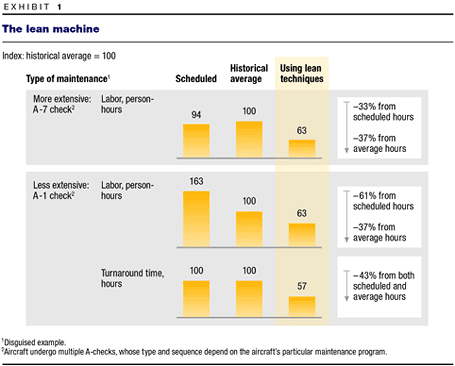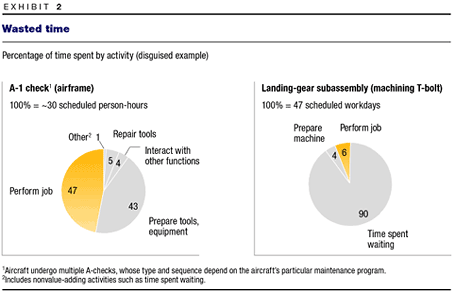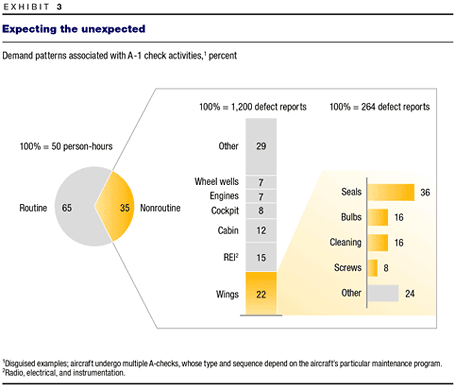Airline operations present a striking dichotomy. Each day, the airlines achieve the remarkable by safely moving nearly five million people more than 40 million air miles around the world. Often, however, they fail to deliver on the ordinary. Once the aircraft land, all too many of them taxi to a jetway and wait—perhaps for a ground crew to arrive and open a door or for the end of the traffic caused by another plane’s maintenance delay. Even standout, low-cost performers lose bags, keep valuable employees idle, depart late, and have billions of dollars in chronically underutilized aircraft and other hugely expensive assets.
These extremes coexist because airlines have historically focused on safety, aircraft technology, speed, geographic reach, and in-flight service attributes; on distinctive regulatory constraints and labor issues; and on the unpredictability imposed by weather and rapidly shifting demand. At the same time, issues such as route structures, excess capacity, pricing, and yield management compete with operations for the airlines’ attention.1 As a result, the airlines haven’t given their operations factorylike, industrial-engineering scrutiny. Great operators in other heavy industries have worked through these challenges to deliver low costs, high quality, and satisfied customers.
Yet up to 45 percent of an airline’s cost structure consists of maintenance, ground handling, in-flight services, call centers, and aircraft acquisitions (which are influenced by operational variables like aircraft downtime). One hundred years after the first powered flight, it’s time to start looking at the airlines as mature industrial companies and to apply proven manufacturing practices that can streamline their process-intensive activities. At stake is an opportunity to reduce overall costs dramatically by using labor, materials, and assets more efficiently, to enhance the reliability of service, and to strengthen flight safety.
Our recent work in the trenches of maintenance and other operations at several airlines has shown us that they can simultaneously make breakthroughs in cost and quality while continually improving their performance in both areas—an achievement known as the "first paradox" of Toyota Motor’s lean-production system. Lean approaches, adopted by numerous industrial and service companies (including many that are heavily unionized and some, like hospitals and medical-device manufacturers, that are highly regulated), are well suited to the airlines’ challenges. As lean techniques eliminate waste, they also root out the nonstandardized work times, variable team structures, and highly asynchronous work flows that many airline executives now view as unavoidable.
The lean approaches of pioneering airlines have begun with the maintenance shop, which functions very much as a disassembly-assembly factory and displays a striking degree of waste and variability. Impressive maintenance results—30 to 50 percent improvements in aircraft and component turnaround times and 25 to 50 percent improvements in productivity (Exhibit 1)—are encouraging signs for the airlines’ other operational choke points, such as baggage handling, passenger loading, and customer service. Applying the philosophy and methods of the lean approach also creates new opportunities for outsourcing and insourcing.

In any industry, companies that adopt lean techniques face difficulties, such as getting senior management committed to the effort, developing the talent pool to lead it, and avoiding the "pick-and-choose" lean-tool-kit approach, which in the end fails to address the root causes of problems. Yet precisely because the lean journey is difficult, the gains won by airlines that persevere with it are more likely to be truly differentiating and sustainable than those resulting from more imitable tactics, such as extracting wage concessions or cutting service. As the industry struggles through the most severe downturn in its history, now is the time to begin.
From Camry to cockpit
When airline executives talk operations, more often than not they focus on the features that distinguish their industry from others. Yet an airline orders materials just as a factory does, and it sequences work, deploys workers to specialized tasks, commits itself to quality levels, and at regular intervals turns out the equivalent of products—serviced and airworthy aircraft. Conversely, like airlines, factories face variability when large orders roll in unexpectedly, equipment breaks down, or snowstorms interrupt supplies.
For all these reasons, the factory floors of strong operators hold important lessons for airlines. Toyota’s lean-production system is legendary: the company’s cars routinely win quality awards, its capital efficiency is extraordinary, and a lot of its plants have breakeven points at 30 to 40 percent of capacity. Many close cousins of the companies in the airline industry—Airbus UK, Boeing, Bombardier, Lockheed Martin, Pratt & Whitney, Sikorsky Aircraft—have strategic lean programs in place.
Underlying lean techniques are four principles: the elimination of waste, the control of variability, flexibility, and the full utilization of human talent. These principles have enormous relevance for organizations concerned with safety, customer service, and unpredictable events such as weather. Companies that embrace lean really begin to see things differently. Our work with several international carriers and with a European third-party maintenance provider has provided a glimpse into this tremendous opportunity.
In spite of the strong cost-cutting efforts of the airlines, they still harbor large amounts of what lean practitioners define as waste: anything that doesn’t add value for end customers. Waste starts with the utilization of aircraft and other kinds of infrastructure, which often falls below 50 percent. Passengers see a part of this problem in the form of empty gates, avoidable tarmac delays, and idle planes. Behind the scenes things really get interesting: engines worth $20 million languish on 40-day journeys through overhaul lines; cavernous hangars suffer from chaotic layouts; awkwardly choreographed hangar dances feature aircraft worth as much as $150 million.
Valuable and highly skilled employees routinely spend a large part of their time on low-value activities or just plain waiting (Exhibit 2). The arriving traveler watches in frustration as a baggage carousel remains empty for 30 minutes because of a lack of handlers. Dozens of stranded travelers fume while a single clerk processes them. In maintenance hangars, mechanics spend far more time chasing parts than repairing aircraft. Moreover, airlines struggle to tailor the level of staffing or the pace of work to their service demands efficiently—despite the predictability of many tasks, such as the removal of wheels. In some maintenance shops, 20 to 30 percent of the mechanics’ time is spent in the break area; in others, actual clocked person-hours are 30 percent lower than scheduled hours.

Standard operating procedures exist, but the airlines generally focus on what regulators such as the US Federal Aviation Administration (FAA) require them to do, not on how to do it efficiently. Thick manuals outline tasks but without standardizing sequences, processing times, or best practices. Passengers experience this problem firsthand in the form of check-in and loading procedures that vary from airport to airport or even gate to gate. The absence of operating standards often breeds inefficiency in spite of workers’ best efforts to carry out required tasks and meet regulatory standards. We’ve seen two mechanics using different tools—one half as effective as the other—to remove a panel from the underside of a fuselage.
The suitability of lean techniques to meet these and other challenges presents the airlines with a ray of hope. What exactly would a lean airline operation look like and deliver?
A view from the trenches
When organizations implement the lean approach, they bring to life its core principles through a distinctive operating system, management infrastructure, and mind-set. Getting these humming takes time. Toyota embarked on its journey 50 years ago and only in the 1970s reached a stage we would recognize as lean, made possible by its well-known suite of specific, practical tools, such as kanban, "fast changeover," "standard work," and hoshin kanri.2 Airlines are just getting started. The pioneers are focusing first on maintenance, generally the second-largest operating expense after fuel. Maintenance has dramatic ripple effects on other operations through its ability—or inability—to service aircraft on time.
The maintenance cornerstone
The aim of maintenance, of course, is to ensure an aircraft’s lifetime airworthiness and safety through the inspection, disassembling, and rebuilding of aircraft structures (wings, fuselage, tail, and cabin, for example) and systems (including avionics, hydraulics, and electronics). Maintenance ranges from quick turnaround "transit checks" between flights to overnight "A-checks" every 500 flying hours to heavy operations that can resemble a Boeing or Airbus assembly line. These are the major "C-checks" and "D-checks"—generally conducted every 18 months and five years, respectively—which can take the aircraft out of commission for days, weeks, even months. National regulators control all maintenance standards and the technical skills required to meet them.
To illustrate the application of lean techniques, we’ll look closely at a single operation—the A-check, analogous in role (but not complexity) to servicing a car. Picture the scene: an aircraft pulls into a hangar late at night. Schedulers "job-card" the list of tasks to be performed and coordinate tooling, spare parts, and staffing. Engineers define the person-hour workloads. Supporting departments and workshops, such as materials management and avionics, provide parts. As if the number of parties involved didn’t generate enough complexity, many nonroutine issues are created by cracks, leaks, system faults, and extraneous damage (for instance, engine damage from bird strikes). The goal is to wade through the surprises and get the plane on the flight line by morning.
A new operating system. Adopting a lean operating system first requires an organization to search for order in the demand patterns of its "customer" (in this case, flight operations). When this discipline is applied to the maintenance shop, only a third of all A-check activities turn out to be nonroutine. Of the nonroutine work, nearly a quarter is accounted for by wing maintenance, which overwhelmingly involves just four areas (Exhibit 3). Standard preparations for them transform nearly 20 percent of all nonroutine A-check tasks into routine ones. A better system for replacing lightbulbs makes almost 5 percent of all currently unpredictable A-check operations routine. Most maintenance organizations already know that nonroutine work is clustered, but few have reliable records or analyses to make sense of the patterns.

Such knowledge helps an operator create standard tasks and workplace designs. Drawing on the collective expertise of its mechanics, it could develop standard work routines, making use of enhanced tools and fixtures, that would substantially increase the efficiency of their wrench time. During A-checks, for instance, they sometimes lubricate parts using a two-person, hand-pumped grease gun while a hydraulic model that allows one person to do the job sits idly in a corner. Arraying such tools at the ready in a highly organized work space can yield large efficiencies. Pre-staging parts such as replacement filters eliminates a source of error by ensuring that they won’t be overlooked. Mechanics become surgeons, with all their equipment and tooling arranged carefully ahead of time and reliable procedures in place to deal with surprises. Simply by eliminating ongoing searches for parts, tools, and paperwork, a carrier may improve the productivity of its repair operations by more than 30 percent.
Standardization progresses as operators determine the actual time needed for each task, along with the sources of variation. Rather than stepping away to find a tool, mechanics stay by the aircraft and visually signal their tool and part requirements. As they work, they note any flaw in the process and perfect it for the future.
Well-defined, standard work practices make more rigorous scheduling possible. Standard completion times and best-quality sequences help operators divide and balance their workloads so that they can choreograph aircraft movements during nightly A-checks. (In a carefully scheduled lean system, everyone knows that a 767 will come through the door at a certain time and will exit, say, two hours and 40 minutes later.) That level of scheduling rigor helps companies match their staffing levels with work sequences more accurately. Meanwhile, demand-based materials replenishment—made possible by kanban signals that directly link upstream activities to actual usage—locks in replacement parts and minimizes surprises.
Improved information flows and standard job practices combine to make schedules more stable and introduce an operating pace, formerly a novelty for repair operations. Keeping the front line informed is vital, particularly in maintenance shops where aircraft move slowly and no formal assembly line provides rhythm and discipline. In a lean A-check, marks on the hangar floor inform the tug operator and the mechanics where a plane will stop, equipment will be kept, and workers will be deployed. Performance-management boards close to the aircraft convey the status of each task and thus help the team utilize resources efficiently and in real time. Workers use these boards, a visual form of communication involving the whole team, to transfer information on progress rapidly. Through visual card displays, mechanics can see the pace of a job and learn the job sequence of the turnaround. The team counts its time-to-completion visually. When the check is done, the team draws on the board’s performance data to see how it could improve.
Management and mind-set. In most successful transformations, the CEO, the COO, and the division president not only talk about lean but also go on "waste walks" to check out the reality of the maintenance shops. The president of one commercial maintenance operation overhauling military planes kick-started a struggling lean program by holding short daily meetings on the hangar floor. Productivity rose by 50 percent within 18 months because the whole organization—from frontline workers to previously skeptical managers—came to recognize the importance of continual improvement. In another case, we saw dramatic improvements in turnaround times when A-check teams learned from senior management that hitting a set of objectives would help secure insourcing business.
But it’s in the trenches that lean efforts succeed or fail. Frontline maintenance supervisors leave their desks for stand-up roles with their teams. Supervisors view themselves as planners, problem solvers, and coaches responsible for creating an environment in which mechanics talk candidly about waste and variability. An important effect is that workers typically become more aware of results, more engaged, and less adversarial.
Today, most airlines lack operating managers with industrial-engineering or manufacturing backgrounds and promote mostly from within. While some lean talent should be developed organically, jump-starting a lean transformation often requires bringing in fresh blood from related industries (such as aircraft manufacturing) to create and launch a disciplined program. Over time, a core team will emerge to train and support an ever-expanding circle of lean aficionados. Boeing has a very substantial number of top-talent people in its Lean Enterprise Group. Alcoa has some of its best operations people, reporting to senior operating leaders, developing a lean Alcoa production system.
Extending lean
Not every airline needs to overhaul engines. Those that do so distinctively, however, may be able to build a substantial revenue stream servicing planes for other carriers. Such an effort shouldn’t be a knee-jerk reaction to the freeing up of hangar space as lean-maintenance programs gain traction. A critical question for any carrier is whether it has the skills and scale to cover the full range of maintenance needs—including structures, avionics, hydraulics, engines, and electronics—during heavy, light, and transit checks. Airlines with capability gaps may do better to specialize and, if the holes are large enough, to let more natural owners of maintenance services meet many of their needs while they shutter excess hangar capacity. For maintenance-business builders, on the other hand, lean-oriented hangars designed with a true assembly line work flow in mind may be worthwhile.
When operations leaders take their newfound lean vision beyond maintenance, they see additional opportunities. Consider ground operations. Aircraft worth $100 million or more routinely sit idle at gates. Turnaround times between flights typically vary by upward of 30 percent. Lean techniques cut hours to minutes with a changeover system that mimics the A-check. The process is disciplined to the standard: one person is responsible for the job; each function is in place and ready to go before the plane arrives; passengers are briefed prior to boarding; flight attendants help stow carry-on baggage to speed seating. We have seen turnaround times at two internationally based carriers reduced by 20 to 40 percent in this way (Exhibit 4).

Baggage handling is another lean candidate. Most business travelers would now rather lug a 20-pound bag through a mile of airport walkways and security checks than put up with the current system. But just as in maintenance, lean techniques can reorganize work flows, standardize tasks, and improve visibility. At most airports, there is no physical reason airlines can’t deliver baggage with 100 percent accuracy in the time it takes a passenger to walk to the baggage claim—and would that systemically speed up boarding!
Lean techniques can also help customer service. A lean check-in system would lift throughput by segmenting passengers: most would be handled routinely, the rest by special-service agents. It would also carefully match staffing to passenger-arrival rates, standardize best practices, and monitor processing times. (A casual review of an airport check-in counter reveals that process times vary among agents by more than 50 percent.) In addition, such a system would systematically eliminate the root causes of slowdowns and supply a well-rehearsed set of protocols to deal with uncontrollable events, such as weather-driven cancellations.
The journey to great operations
The idea of 25 to 50 percent improvement opportunities is enticing, but airlines shouldn’t underestimate the magnitude of the task; truly lean companies like Toyota are rare for good reason. Projects and events that aren’t inspired by broader transformation goals lead to what we saw at one airline: a maintenance shop that dramatically reduced the number of tools it needed but didn’t know how that achievement affected turnaround times or aircraft utilization rates. Far better to determine how many more hours an airline must keep its planes in the air, to identify the bottlenecks (perhaps in the C-check) to achieving that level of performance, and to design a lean system around the bottlenecks (say, the removal of seats).
Even with the right goals in place, adopting individual lean techniques won’t get airlines far unless they tackle more difficult issues, such as standardizing their work and changing the role of their frontline supervisors. Underpinning such efforts is a commitment from the top to a cultural change emphasizing, above all, the identification of waste, rigorous problem solving by the front line, and a focus on fully utilizing aircraft and other assets. In our experience, two things are central to achieving this mind-set shift: a trial that serves as proof of concept for the complete system and the rigorous development of lean skills among middle managers.
Yet these difficulties come with a silver lining: the potential for successful lean practitioners to achieve truly distinctive cost and quality structures. When airlines make cuts, they typically focus on reducing wage, food, and other supply costs that they can easily control—and that competitors can easily match. As deep as recent cost-reduction efforts in the United States and Europe have been, an airline that fully embraced lean operations could slash its overall costs by a further 5 to 10 percent. And even as competitors contend with the expiration of temporary labor concessions, lean operators will extend their edge through continual improvement. In other process-, labor-, and capital-intensive industries, the superb operators win. In the airline industry, the pendant is still up for grabs.
Airlines aren’t unique; they can embark on the same lean journey that has taken operational leaders in other industries to great heights. It won’t be easy, but it will differentiate the determined few that persevere.

